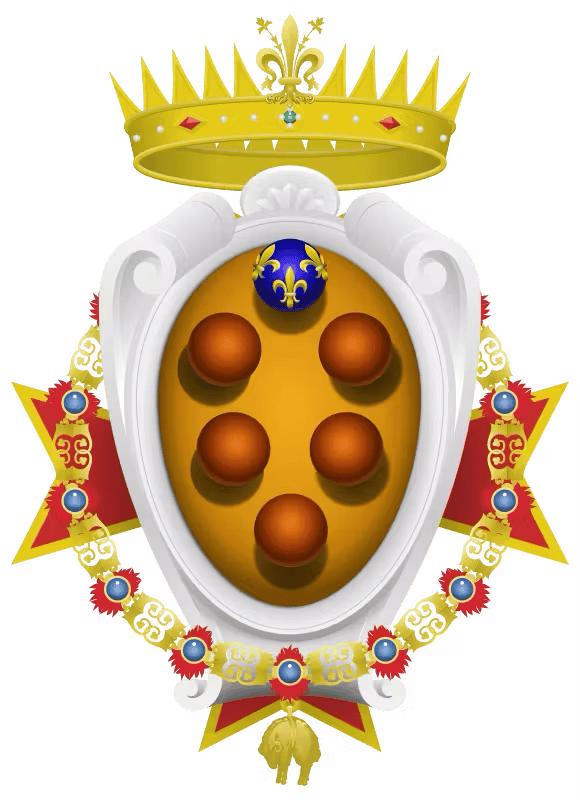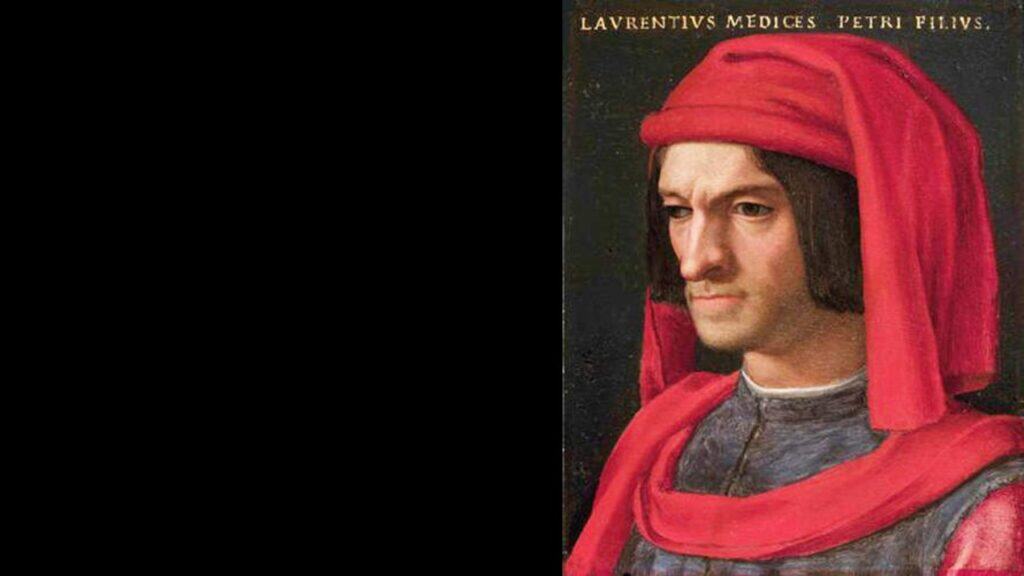The Medici family, most likely, comes from a rural area called Mugello, about 30 km from Florence. We are in the 1100s and three lines of descent constitute the Medici family: Bonagiunta, Chiarissimo and Averardo.
The progenitor is considered to be Averardo de’ Medici, a textile-agricultural merchant and member of the petite bourgeoisie who decides to move to Florence because it is a city in continuous economic expansion, and therefore represents an excellent business market. Upon his death, his son Giovanni Di Bicci takes over the family and successfully invests the father’s inheritance. This establishes the Medici bank, the largest deposit of the entire 15th century.
Cosimo de’ Medici and the “First Expulsion of the Medici”
The firstborn of Giovanni de’ Medici is Cosimo, called Cosimo the Elder. A very learned man, and above all, a supporter of the arts.
He becomes manager of the family bank, in competition with the other two Florentine families, Strozzi and Albizzi. Cosimo opens branches throughout Europe and forges important political alliances.
In 1433 he is arrested on charges of having caused unrest within the city. He is sentenced to exile in the city of Venice and the event will go down in history as the ‘first expulsion of the Medici‘.
The “Council of One Hundred”
Just a year after this incident the Florentine institutions are in collapse and the Signoria meets and votes for the return of the Medici. Having returned to his homeland, Cosimo founds the ‘Council of a Hundred’, and becomes the most powerful man in Florence.
Under his dependence work illustrious artists such as Vasari, Donatello and Brunelleschi to transform the city and make it magnificent in the eyes of the world. For this he will be awarded the title of ‘Pater Patriae‘ shortly after his death.
The financing of artistic works will also be carried out by the Medici family as an affirmation of family power. The Medici become patrons of philosophers and architects, including Brunelleschi, who introduces the concept of ‘central perspective’ and completes the dome of Santa Maria del Fiore, Ghiberti who creates the door of the Florentine baptistery, Donatello who sculpts prestigious statues like ‘Judith and Holofernes’, Botticelli whose fascinating paintings like ‘The Venus’ and ‘The Spring’ can be admired at the Uffizi, Leonardo Da Vinci apprentice of Verrocchio, leaves the city an inestimable artistic and scientific heritage, Michelangelo sculptor of the ‘David’, today at the Academy.
Lorenzo de’ Medici, Known as “the Magnificent”
Thanks to popular support, Cosimo de’ Medici becomes the head of the Florentine government through advantageous marriage alliances with rich and powerful families. Cosimo manages to obtain the title of Grand Duke of Tuscany and carries on the revolution of the Florentine monetary system that must adapt to the new international economic criteria.
Upon his death, his nephew Lorenzo de’ Medici, called the Magnificent, will carry on the main economic activities and artistic projects left in inheritance by his grandfather. Not to be forgotten is that his son, Giovanni di Lorenzo de’ Medici, will become the future Pope Leo X.
For this reason, Lorenzo establishes a solid network of business companies with a key branch in Rome where he accumulates the income from papal tithes and directs a rich market that quickly overwhelms the competition.
In a short time, although with numerous difficulties and family misfortunes, including the murder of his brother Giuliano inside the Cathedral of Santa Maria del Fiore at the hands of the Pazzi family, Lorenzo will succeed in centralizing power in his own hands by applying a reform to the republican institutions that end up under his command, thus restoring relations with the other Italian states to ensure peaceful coexistence for Florence and Italy: with Milan, Naples and Venice.
The Decline of the Medici Dynasty
In the 1600s, the decline of the Medici dynasty began. Italy was dominated by the Spanish, who heavily taxed citizens to increase their own revenues. Moreover, the discovery of America causes the Italian state to lose its role as the primary commercial route. To this is added the plague epidemic that in waves strikes the population, halving it.
The Medici family, currently represented by Gian Gastone, is characterized by a weak government and devoted only to ostentation and unable to counter the difficulties of the country. Unfortunately, the only female, Anna Maria Luisa, his sister, will not be able to guarantee the succession of the house because she is sterile.
However, her figure will become fundamental through the so-called ‘Family Pact’: in 1737 she signs with the future successors, the Habsburg-Lorraine, the ‘Family Pact’ with which ‘They cannot transport or remove from the Capital and the State of the Grand Duchy, Galleries, Paintings, Statues, Libraries, and other precious things, of the succession of the Most Serene Grand Duke, so that they may remain for the ornament of the State, for the utility of the Public and to attract the curiosity of Foreigners’.
Thanks to her, Florence is today the capital of the European Renaissance and everywhere you can breathe and admire the legacy of the Medici.
First of all, the palaces, including Palazzo Vecchio, the official seat of the dynasty since 1540, Palazzo Pitti, the last residence of the house, boasts the presence of the Palatine Gallery where a substantial part of the Medici art collection is preserved, works by Caravaggio, Raphael, Titian, Palazzo Medici–Riccardi commissioned by Cosimo in1444.
Architecturally, the Medici financed the construction of the Uffizi Gallery, the Basilica of San Lorenzo, the Medici Chapels, the Ospedale degli Innocenti, Palazzo Medici Riccardi, the Cathedral of Santa Maria del Fiore, and the first library. They also restored the Boboli Gardens and Palazzo Pitti. In Rome, on the other hand, they sponsored the Basilica of St. Peter’s.


